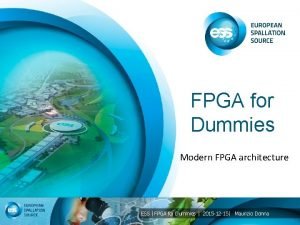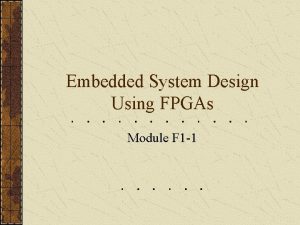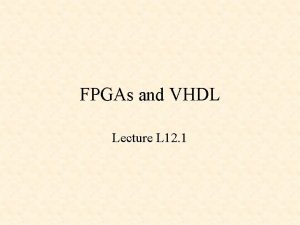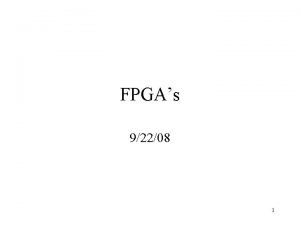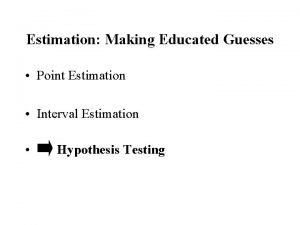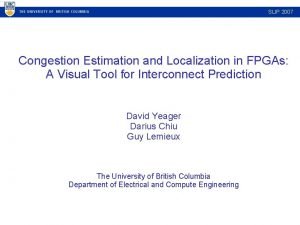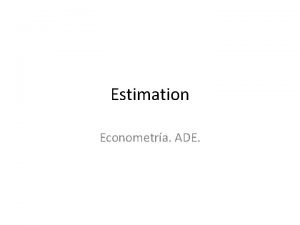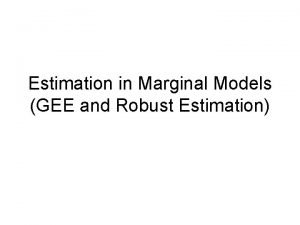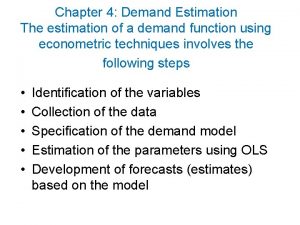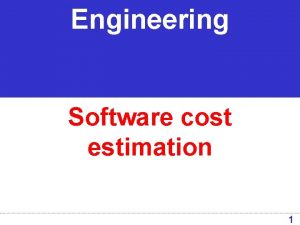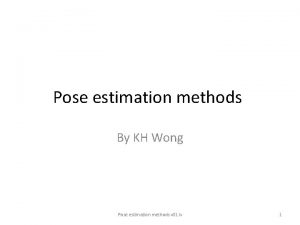Estimation of SEUs in the FPGAs C TargettAdams









![Other FPGAs threshold SEU s [Me. V] [cm 2/device] FPGA year Virtex II X-2 Other FPGAs threshold SEU s [Me. V] [cm 2/device] FPGA year Virtex II X-2](https://slidetodoc.com/presentation_image/f6a91731edffcf66b655bf44b3ae4258/image-10.jpg)








- Slides: 18

Estimation of SEUs in the FPGAs C. Targett-Adams V. Bartsch, M. Wing M. Warren, M. Postranecky

FPGAs magnet ECAL, 30 slabs stacked on top each other, in z direction 25 slabs next to each other extends to |eta|=1. 1 HCAL very frontend electronics (VFE) based on ASICs frontend electronics (FE) based on FPGAs, 1 FPGA/slab

SEU dependence critical energy ( depend on angle and entry point of the incident particle and its energy at each point of the volume) sensitive volume (can be guessed by irradiating with different ions with a different linear energy transfer, plus guessing the dephts of the device => Weibull fit which gives the cross sectional area of the sensitive region per node) look for particles which deposit much charge in small area

SEU dependence critical energy sensitive volume look for particles which deposit much. Weibull fit described in E. Normand, Extensions of the Burst charge in small area Generation Rate Method for Wider Application to p/n induced SEEs

interesting physics processes • ttbar: – 50 -70 events/hour depending on CMS energy • WW – 800 -900 events/hour • QCD events – 0. 02 -0. 1 ev/BX => 7 -9 Mio events/hour – Photon/photon 0. 1 -0. 02 per bunchx from the TESLA TDR

simulation turns out that one can not make too many spatial cuts Þ need to simulate whole events Þ slow simulation times ttbar event Cut: |eta|<2 Selection: ttbar: 246/500 events WW: 230/5000 events QCD: 239/50000 events

energy spectrum of particles in the FPGAs QCD WW ttbar

SEU - Weibull Fit Þ above 20 Me. V neutrons start doing upsets IEEE Transactions on Nuclear Science Vol. 50, No. 2, 2003 Gingrich

SEU s. p, n, pi hits/hour above 20 Me. V ttbar 5 WW 2 QCD 70 probability of SEU/h 0. 0010 Þone SEU/device every 40 days
![Other FPGAs threshold SEU s Me V cm 2device FPGA year Virtex II X2 Other FPGAs threshold SEU s [Me. V] [cm 2/device] FPGA year Virtex II X-2](https://slidetodoc.com/presentation_image/f6a91731edffcf66b655bf44b3ae4258/image-10.jpg)
Other FPGAs threshold SEU s [Me. V] [cm 2/device] FPGA year Virtex II X-2 V 100 & Virtex II X-2 V 6000 2004 5 Me. V 8*10 -9 Altera Stratix 2004 10 Me. V 10 -7 Xilinx XC 4036 XLA 2003 20 Me. V 3*10 -9 Virtex XQVR 300 2003 10 Me. V 2*10 -8 9804 RP 1998 20 Me. V 10 -8 all data from literature, references not given in talk It has been assumed that each device consists of 106 bits in order to make the numbers comparable

Other FPGAs Virtex II X-2 V 100 Virtex II X-2 V 6000 0. 005 SEUs/h Altera Stratix 0. 062 SEUs/h Xilinx XC 4036 XLA 0. 001 SEUs/h Virtex XQVR 300 0. 012 SEUs/h 9804 RP 0. 005 SEUs/h

other radiation effects • neutron spallation: – non-ionizing effects like nuclear spallation reaction, which make neutrons stop completely => leads to destruction of electronics – depending on 1 Me. V neutron equivalent fluence, no comparison to measurements up to now • deep level traps: – cause higher currents – depending on radiation dose (energy deposition in the electronics), not yet done

NIEL hypothesis according to Vasilescu and Lindstroem, on-line compilation annual 1 Me. V neutron equivalent fluence assuming 107 s: 104 /cm 2 (factor 1010 smaller than inner detector@LHC )

Radiation dosis • strategy 1: take worst case scenario • look at innermost layer which has most hits • take the whole energy loss => also non electromagnetic energy loss => 0. 003 rad/year • strategy 2: estimate from the flux calculated for the SEUs • take average energy from spectrum for each particle => 0. 003 rad/year

Radiation dosis • strategy 1: take worst case scenario Energy deposited: (1952 Me. V / 6986 events) * (9 Mio events/hour / 3600 sec) * 107 sec/year = 7*109 Me. V ==0. 001 J with 1 e. V=1. 6*10 -19 J Volume/mass: V = (24 Mio cells/40 layers) * 1 cm 2 * 300 mm =0. 018 m 3 m = 0. 018 m 3 * 2330 kg/m 3 = 42 kg Radiation dosis: 0. 001 J/42 kg = 2. 8*10 -5 J/kg (Gy) == 2. 8*10 -3 rad

Breakdown of FPGAs Xilinx Virtex XQVR 300 TID XC 4036 XLA Radiation dosis before error occured 100 k. Rad 60 k. Rad 42 k. Rad => we should be safe using FPGAs

radiation monitors (inspired by Rad. Mon group at LHC) SEUs: Dose: Fluence: SRAM with high SEU probability Radiation Sensitive MOSFET or Gate Controlled Diodes Si diodes or Gate Controlled Diodes

occupancy - for the barrel Hits per bunch train (assuming Gauss distribution of events) hits per bx number of cell_ids hit Þ Occupancy per bunch train: 12000 hits/24 Mio cells = 5*10 -4 number of cell_ids hit
 Mmcme
Mmcme Basic fpga architecture
Basic fpga architecture Embedded microprocessor system design using fpgas
Embedded microprocessor system design using fpgas Ng-html
Ng-html Tư thế ngồi viết
Tư thế ngồi viết Thẻ vin
Thẻ vin Cái miệng bé xinh thế chỉ nói điều hay thôi
Cái miệng bé xinh thế chỉ nói điều hay thôi Mật thư tọa độ 5x5
Mật thư tọa độ 5x5 Hươu thường đẻ mỗi lứa mấy con
Hươu thường đẻ mỗi lứa mấy con Thang điểm glasgow
Thang điểm glasgow Diễn thế sinh thái là
Diễn thế sinh thái là Thế nào là giọng cùng tên?
Thế nào là giọng cùng tên? Thể thơ truyền thống
Thể thơ truyền thống Các châu lục và đại dương trên thế giới
Các châu lục và đại dương trên thế giới Thế nào là mạng điện lắp đặt kiểu nổi
Thế nào là mạng điện lắp đặt kiểu nổi Bổ thể
Bổ thể Lời thề hippocrates
Lời thề hippocrates Vẽ hình chiếu vuông góc của vật thể sau
Vẽ hình chiếu vuông góc của vật thể sau đại từ thay thế
đại từ thay thế

